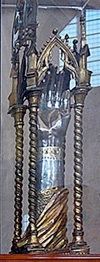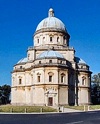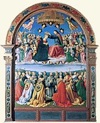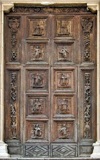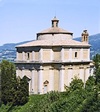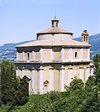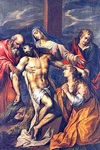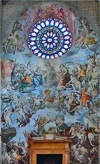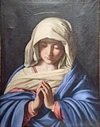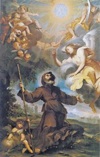

Cataluzio di Pietro da Todi (died after 1419)
Cataluzio di Pietro was a goldsmith who also played a civic role in Todi. His work is known from a signed gilded silver chalice and paten (late 14th century) from San Domenico, Perugia, which is now in the Galleria Nazionale there. The reliquary (early 15th century) in the sacristy of San Fortunato that contains the arm of St Fortunatus is attributed to him.
Lello da Velletri (died after 1437)
The only securely attributed work by Lello da Velletri is a signed polyptych (ca. 1421) from Santa Maria Novella (later San Benedetto dei Condotti), Perugia that is now in the Galleria Nazionale there. A documented work (1437) in Santa Maria a Montecchio di Baschi, outside Todi no longer survives. The following frescoes in the Cappella dell’ Annunziata of Santa Maria in Camuccia are attributed to him:
-
✴the detached fresco of the Annunciation, which is now on the entrance wall of the chapel was rediscovered in 1968 on the back wall (illustrated here); and
-
✴the frescoes of the Evangelists in the vault, of which only one (St Luke) survives.
Bartolomeo di Mattiolo (died 1473)
Bartolomeo di Mattiolo, who was based in Perugia from at least 1437, became the leading architect in that city. He worked on the vaults of San Fortunato in 1458-62.
Giovanni Tedesco (late 15th century)
German
[A Crucifix in Museo Civico, from Montesanto??]
[Temporary link to Giovanni Tedesco]
Nicolò di Liberatore, l' Alunno (1430-1502)
Nicolò di Liberatore was perhaps the most important participant in the vibrant artistic milieu of Foligno in the 15th century. The main panel of a documented altarpiece (1491) from Santa Maria delle Grazie, which was by Nicolò di Liberatore and his son, Lattanzio di Nicolò (below), has been lost. The Commune of Foligno bought the predella panels in 1950, and they are now in the Pinacoteca Civica, Foligno.
Cola di Matteuccio da Caprarola (died after 1519)
Cola da Caprarola is documented in relation to Santa Maria della Consolazione from 1508, at the start of the project, until 1512. He is sometimes named in the associated documents as the architect, but nothing in his known career suggests that he could have designed the church.
Lattanzio di Nicolò (died after 1527)
The main panel of a documented altarpiece (1491) from Santa Maria delle Grazie, which was by Nicolò di Liberatore and of his son, Lattanzio di Nicolò (below), has been lost. The Commune of Foligno bought the predella panels in 1950, and they are now in the Pinacoteca Civica, Foligno.
Giovanni di Pietro, lo Spagna (died 1528)
The considerable number of works by or attributed to lo Spagna in Todi include this important panel (1507-11) of the Coronation of the Virgin from Santa Maria di Montesanto, which is now in the Pinacoteca.
Antonio Bencivenni (died 1528)
Antonio Bencivenni was a woodcarver who was based in Perugia in ca. 1498-1518 and subsequently in Todi. He carved the portal (1513-21) of the Duomo (although the lower part was subsequently hit by lightening and had to be replaced in 1623. As an old man, he worked alongside his son, Sebastiano, on the choir (1521-30) of the Duomo, but died before the work was complete.
Giannicola di Paolo (ca. 1460-1544)
From Perugia
The altarpiece (1516) over the altar at the end of the navatina of the Duomo, which is attributed to Giannicola di Paola, came from the Abbazzia San Pancrazio di Collepepe outside Todi. It depicts the Madonna and Child with SS Catherine of Alexandria and Roch. The Pietà in the lunette has been effectively repainted, and the predella is lost.
[Temporary link to Giannicola di Paolo]
Antonio da Sangallo il Giovane (1484-1546)
From Florence
Antonio Maffei (died after 1598)
From Gubbio
Antonio Maffei carved the choir stalls (1590) of San Fortunato.
[Temporary link to Antonio Maffei]
Felice Damiani (died after 1609)
From Gubbio
Felice Damiani left a executed a number of works in his native city in the period from ca. 1594. A panel (1581) of the Deposition in the Pinacoteca, which came from [il Convento dei Camaldolesi della Canonica, near Todi - where is it??], is signed by Felice Damiani and dated by inscription.
[Temporary link to Felice Damiani]
Ippolito Scalza (1532-1617)
Ippolito Scalza took over the project to build the of the Tempio del SS Crocifisso (illustrated here - see Valentino Martelli below) in 1594, and brought it almost to completion. His “temporary” wooden roof survived from 1610 until 1748, when the present cylindrical dome was built. He was also paid on a number of occasions for advice on Santa Maria della Consolazione. The portal of Palazzo Cesi (ca. 1600) is attributed to him.
Valentino Martelli (1550-1630)
Valentino Martelli was responsible for the first design (1589) and probably for the second design (1592) of the Tempio del SS Crocifisso (illustrated here).
[Santa Maria della Consolazione]
Hendrik de Clerck (died 1630)
Hendrik de Clerck was documented in Italy only once: in Rome in 1587. He subsequently returned to the Low Countries, where he was appointed as court painter to the Archduke Ernest in Brussels in 1594. This fine altarpiece (late 16th century) in Santa Prassede, which depicts the Deposition of Christ, is attributed to him. It is undocumented and its original location is unknown.
Pietro Paolo Sensini (1555-1632)
Most of the surviving works by or attributed to Pietro Paolo Sensini are in his native Todi. This altarpiece (1592) of the Madonna and Child with saints from San Fortunato is one of the earliest that is securely attributable to him. It is now in the Museo della Città.
Bartolomeo Barbiani (died 1645)
From Montepulciano
Text
[Temporary link to Bartolomeo Barbiani]
Ferraù Fenzoni (1562-1645)
Bishop Angelo Cesi called Ferraù Fenzoni from Rome to Todi in 1593 and he remained there until 1599, when he returned to Faenza. His many surviving works in Todi include this fresco (ca. 1596) of the Last Judgement on the counter-facade of the Duomo.
Andrea Polinori (1586-1648)
Most of the surviving works by or attributed to Andrea Polinori are in Todi. This altarpiece (1635), which Girolamo Benedetti commissioned for his family chapel in San Fortunato, is attributed to Andrea Polinori. The altarpiece, which depicts a vision of Jacopone of Todi (Girolamo Benedetti’s ancestor), is now in the Pinacoteca.
Cesare Sermei (1584- 1668)
From Orvieto; trained in Rome; moved to Assisi
The fresco cycle (1612) of Scenes from the Passion of Christ on the walls and ceiling of the Cappella della Crocifissione of Santa Maria di Montesanto is signed by Cesare Sermei. He described himself as “Assisas” (from Assisi): this is, in fact his earliest known altarpiece from the period after 1611, when he became a citizen of Assisi.
[Temporary link to Cesare Sermei.]
Giovanni Battista Salvi, il Sassoferrato (1609-85)
This small panel, which has recently been attributed to il Sassoferrato, which depicts a half-length figure of the Virgin with her hands together in prayer It came from an unknown location and is now in the Musei Civici.
Giacinto Boccanera (1666-1746)
This panel (1712) depicting San Francesco di Paola from San Fortunato is now in the Pinacoteca. An inscription discovered during its recent restoration revealed that Giacinto Boccanera painted it in 1712.
Annibale Brugnoli (1843-1915)
From Perugia
Annibale Brugnoli studied at the Accademia di Belle Arti di Perugia. He painted a scene of the arrival in Todi of Lodovico Ariosto on the fire curtain of Teatro Comunale di Todi.
[Temporary link to Annibale Brugnoli]
Return to the home page on Todi.
